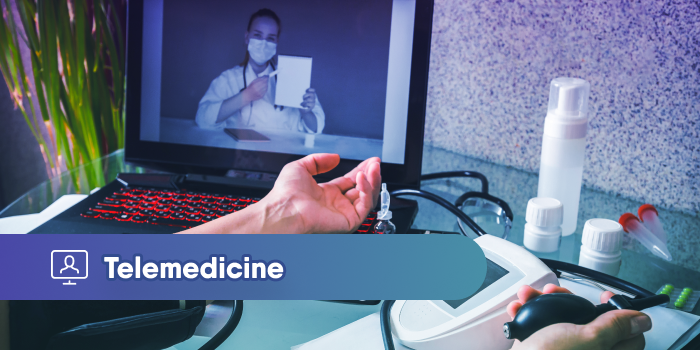How Telehealth Improves the Patient Experience
Healthcare professionals (HCPs) have long sought and struggled to assess and improve healthcare quality in the United States. The Agency for...

Telehealth enables patients to be more engaged with their healthcare providers as it provides them easier access and greater convenience to care.
Healthcare providers from all over the world have acknowledged the capabilities of telehealth as it continues to expand across the healthcare industry and create a significant impact on patient engagement. Telehealth programs empower patients to be more engaged with their care, keep track of their medical records, and promote the decision-making processes for their treatment outcomes and overall wellness
Although telehealth is the practice of delivering healthcare services remotely, patients do not feel distant from their healthcare providers as telecommunication technology plays a crucial role in establishing patient engagement using video conferences, SMS, and remote patient monitoring (RPM).
Read on to learn more about how telehealth enhances patient engagement, which is vital in medical practice today as more patients want remote healthcare services.
Some people often rely on the internet for self-diagnosis whenever they feel any symptoms that may or may not be a sign of an illness. While there are reliable sources for medical information on, for example, Mayo Clinic, Google, and WebMD, patients should avoid self-diagnosing because of accuracy concerns. According to a report published by the Pew Research Center, one out of three US adults says that at one time or another, they have gone online to figure out a medical condition they or someone they know might have.
Medical diagnosis is a serious healthcare matter that physicians deal with regularly. However, many people would choose to search first on the internet for a self-diagnosis because it is quicker and easier than visiting a doctor. Some patients may lack the personal motivation and discipline needed to take the necessary steps in dealing with their healthcare when they would rather rely on resources from the internet. They often put off seeking medical care until their condition worsens.
Telehealth offers a much better alternative allowing patients to receive the necessary medical care in minutes. It introduces a revolutionized way of how patients receive medical care without leaving their homes and with a virtual presence of a physician. The barrier that used to hold patients back in reaching out to physicians for any medical matter due to the availability of the internet is gone. Telehealth has made it simple and easy for healthcare providers and patients to communicate remotely — by texting or video conference — which is critical in improving patient engagement.
Moreover, the use of telehealth to reach patients in non-healthcare settings or outside a medical institution is a vital component in overcoming other barriers to care, including lack of healthcare access in rural areas, transportation problems, or the fear of contracting an illness at a physician’s office, such as COVID-19 or the flu.
Telehealth simplifies access to care. It helps improve patient engagement because access to care is more readily available, regardless of where the patient may be, and the use of technology is easy, so patients do not feel overwhelmed when managing their health.
Patients participate in their healthcare when they can do it more simply and reliably. They only need to experience the convenience of telehealth from passive to active partners in their healthcare.
In a traditional healthcare setup, patients go to their physician’s office or clinic when they are not feeling well or need treatment. They book their appointments over the phone with the front desk and wait for their time to see the physician.
The times have changed, though. Healthcare providers have shifted to telehealth platforms to sustain and increase patient engagement. No longer is an in-person appointment needed for many symptoms or illnesses — and patients like that.
Patients have different responses when it comes to healthcare management. Some just wait for a doctor to check their condition and prescribe them medication, while others, often with a serious illness, want to know more about their disease and the treatment process. Telehealth works for both types and can transform a passive patient into an active participant.
Telehealth modalities such as video conferencing, online medical record access, and remote patient monitoring (RPM) provide patients virtual care options to actively engage in their healthcare even without the physical presence of a physician. Telehealth helps to increase patient engagement and change passive patients into active patients by:
Personalized text messaging is also great for physicians to share vital information about a patient’s condition that could help them understand more about it and treatments, such as sending a link to an online article or study
Healthcare providers are actively leveraging telehealth to establish an effective rapport with patients and motivate them to be involved with their healthcare.
Physicians can treat their patients as partners in healthcare because of their direct involvement made possible through technology. It can also increase patient trust, as communication is easier, whether for questions about a condition, medication, or diagnosis.
Regardless of the healthcare practice’s size, employee structure, or patient demographics, any telehealth system is a solution to communicate with and engage patients in their care, entrust them to improve lifestyle habits, and take more control in managing their healthcare conditions and treatments.
Telehealth transforms medical practices into a patient-centered care model, which keeps the patient at the center of the treatment. Simply put, patient-centered care focuses on providing the patients’ needs to improve access, quality, prevention, and safety to healthcare. Through various telehealth communication platforms, healthcare providers can facilitate health education while providing monitoring and management.
As a result of patient-centered care that improves communication, patients are well-informed about their condition and become proactive in taking preventive measures and making decisions about their treatments and overall wellness. That exponentially increases patient engagement since patients feel recognized for their role in healthcare management.
The following are points that describe the impact of telehealth in patient-centered care:
By now, most experts agree that providing patient-centered care is central to high-quality healthcare. Through patient responses, healthcare providers continuously improve their healthcare delivery and market health plans and products. Telehealth offers convenience in gathering patient responses through online surveys.
Also, with telehealth, patients can easily schedule appointments and discuss directly with their physicians the care they need. Moreover, they have a chance to ask questions and express concerns. They are more open in discussing if their medication is effective or no longer working as well as before. Using an interactive, 2-way communication channel and a secured SMS platform like Curogram, patients can ask follow-up questions and receive answers quickly even beyond their scheduled appointments.
A study suggests that telehealth, when done right, can be as effective as in-person healthcare. It is most efficient for patients with ongoing conditions or chronic illnesses such as diabetes, heart disease, and lung disease because telehealth makes it easier to have frequent check-ups than in-person care.
The same study also proposed that using telehealth to check minor injuries or illnesses, such as stomach pains or nausea, provides the same level of care as in-person medicine and reduces unnecessary hospital or emergency room visits. However, the complex part is knowing which situations are appropriate for remote healthcare treatment. For example, after making an initial diagnosis of a patient’s large bruise on the arm, the physician can provide primary medical advice such as putting ice on the area and taking a pain reliever. However, if the physician thinks that further care is needed, they recommend taking the next steps, such as an X-ray to confirm or rule out a fracture.
After connecting with a physician through telehealth, if a patient needs further care, they simply book an in-person visit.
Additionally, telehealth is most effective for patients with mobility issues since they won’t have to overcome difficulties to go to the office.
It is essential to consider that some patients may be reluctant to choose telehealth services. They may feel that the technology is too advanced to understand. So it is every healthcare provider’s job to adequately educate them on the impact of telehealth on their overall care and how easy the whole program works. The more clearly patients understand telehealth, the more likely they adopt it and get involved with their healthcare, producing better treatment outcomes because you can provide the patient education they need virtually.
Telehealth promotes patient education because of the following services:
Patient-centered care correlates with patient engagement. It focuses on the welfare of the patient’s needs and requirements, even after the treatment. At the same time, telehealth provides patient education with direct engagement to healthcare leading to higher levels of preventive health behaviors and increased self-management of health conditions.
Out of all the provided benefits on how telehealth enhances patient engagement, perhaps the most-cited is the ability for patients to attend appointments from any location.
In an in-person setting, missed appointments are quite understandable, especially if a patient needs to endure a long drive to see their physician for an appointment or has unexpected work or home commitments. It’s common for patients to skip scheduled appointments. However, canceled appointments or no-shows generate a significant impact on both healthcare providers and patients.
Difficulty within transportation makes remote healthcare appointments more desirable and no-shows or late cancellations less frequent.
Telehealth also offers more flexibility regarding appointment scheduling since patients can book their appointments via text messages. The idea of not going through the burden of waiting on the phone to book an appointment motivates patients to address their health.
It is critical to opt for a telehealth solution with capabilities that allow your medical practice to proactively engage with patients and adapt to abrupt changes in appointment scheduling when needed. Telehealth solutions like Curogram provide appointment scheduling features efficiently and effectively with additional security to protect a patient’s information.
With Curogram, healthcare providers can create templated HIPAA-compliant text messages and send out appointment reminders to patients. In case a patient wants to reschedule or cancel an appointment, they can simply respond via SMS.
Moreover, physicians can configure the appointment reminder to their patient’s preferences. The reminder can be sent:
That way, patients have enough opportunity to reschedule or cancel the appointment, giving medical staff plenty of time to adjust the calendar and schedule a different visit at that time, ensuring maximum efficiency.
With an opening in your schedule, you can text another patient to see if they would like to change their appointment time to fill the gap. Or, you can accommodate a new patient at that time. Your staff saves time because they don’t have to call these patients — a quick text message is all they need to complete.
If patients have the options to take care of tasks such as scheduling and rescheduling an appointment more conveniently, they are more driven to attend the appointment leading to better healthcare outcomes and increased patient engagement.
The digital age transforms the way consumers access services and transactions. Online shopping sites allow consumers to buy items with just a few clicks on their smartphones or tablets. Online banking provides easy transactions to deposit money, send funds, or pay bills. And telehealth allows a patient to meet their physician without leaving their home.
A telehealth appointment is a video meeting or consultation between a healthcare provider and patient. It includes both video and audio features from a desktop computer, laptop, or even smartphone. With Curogram, patients can join a virtual appointment through a link they receive in an SMS. In just a matter of minutes, they meet with a licensed healthcare professional and receive their required medical care.
Here are some benefits of convenient virtual appointments that encourage patients to be more engaged with their care:
Telehealth is beneficial to healthcare providers and patients as it saves time, is convenient, provides more flexibility in receiving care, and allows patients to have more mental space for a better understanding of their conditions and treatments.
In the era of modern technology, patients own smartphones, tablets, laptop computers, or desktop computers that they can readily use to link with healthcare practitioners comfortably. Telehealth offers access to care with several benefits in healthcare delivery, including the improvement of patient engagement.
Telehealth platforms have become essential to healthcare providers and as alternative care options for patients. Telehealth reduces unnecessary visits to medical institutions, and since telehealth appointments are easy to schedule and reschedule via SMS, patients are more willing to attend their consultations. Patients opt for virtual care as it provides them a more convenient and seamless way to communicate with their physicians without leaving their house or spending time traveling to clinics and staying in waiting rooms.
Telehealth encourages patients to be more proactive in dealing with their conditions, no matter how minor or complicated they may be. By involving patients in medical care decision-making, patient engagement increases knowledge and understanding, leading to positive health outcomes.
Patients can ask questions and receive prompt replies from medical staff through video conferences or SMS. Telehealth platforms such as Curogram use HIPAA-compliant software to allow a secured 2-way communication form between physicians and patients. Being a HIPAA-compliant system, healthcare providers don’t need to worry about violating any privacy regulations on patient health information (PHI).
Moreover, patients are increasingly interested in telehealth as it provides them direct access to their medical records allowing them to make critical decisions on their medical status.
The virtual collaboration of physicians and patients builds a positive relationship between the two to work as one to improve health. When considering telehealth for your practice, do so knowing that patients are comfortable with this technology and want the option to connect virtually with healthcare providers.

Healthcare professionals (HCPs) have long sought and struggled to assess and improve healthcare quality in the United States. The Agency for...

Telemedicine, as a remote patient care model, is not a new practice in healthcare and existed for many years before the COVID-19 pandemic. It was...

Today, people are now more tech-savvy and generally more aware of their health thanks to the internet and a variety of health care apps. Because of...